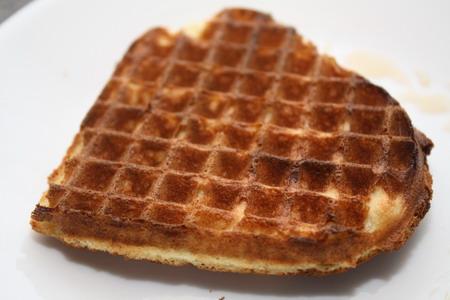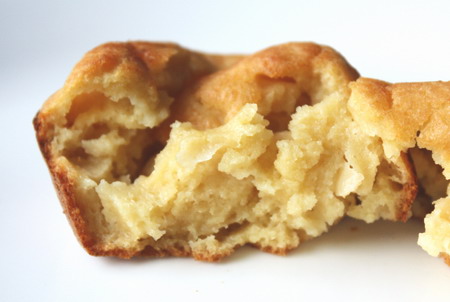Today I tried out the basic yeast-free bread recipe from The Gluten-Free Gourmet Bakes Bread by Bette Hagman, using the Four Flour Bean Mix described in my previous posting with the standard supermarket flours using in Indian cooking (Mustafa being the only supermarket I know that stocks them, though!).

The result was rather uneven: some parts did not rise much – the very smooth, close-textured parts – and other parts had huge air bubbles.
However, taste-wise and in terms of ‘mouth-feel’, I’m pleasantly surprised! The very green smell from the green bean flour disappeared after baking, and the bread was springy to the touch, much like real bread (despite the cake-like appearance). Actually, the texture reminds me very much of kueh lapis!
I tried it with a variety of savoury and sweet toppings as well as plain with butter, and it tasted fine every time. I couldn’t stop eating… how wonderful to be able to eat ‘bread’ and not be worrying about exceeding my wheat & gluten limit.
The recipe for a small loaf:
DRY INGREDIENTS
2 cups Four Flour Bean Mix : I used 1/3 part chickpea flour, 1/3 part green bean flour, 1/3 part sorghum flour, 1 part cornstarch, 1 part tapioca starch
1 1/2 tsp Xanthan gum
3 Tbs brown sugar [which I reduced to 2 Tbs – still rather sweet]
1/2 tsp baking soda
2 tsp baking powder
1 tsp Egg Replacer [omitted; Hagman uses this to provided additional protein and leavening power]
1/2 tsp salt
WET INGREDIENTS
Eggs – 2 plus 1 white [I used 3 small whole eggs, also because I omitted the Egg Replacer]
2 Tbs melted butter [replaced with ghee as I was too lazy to melt butter!]
1 Tbs honey [replaced with light argave syrup]
3/4 cup buttermilk [used substitute]
approx 1/3 cup water [used much, much less]
[Hagman also uses optional dough enhancer, which I have omitted completely here.]
Preheat oven to 180°C. Grease loaf pan(s) and dust lightly with rice flour.
Whisk together dry ingredients.
In a large bowl, beat eggs and egg white(s). Add melted butter, honey and buttermilk. Blend with mixer on low speed.
Add dry ingredients and continue to blend on low speed.
Add ‘sufficient water to make the dough the consistency of cake batter.’ This was the hard part! What is the correct consistency? I’ve seen a whole range of consistencies of cake batters. Anyway, using my judgement, I only needed to add about a tablespoon of water. The batter was strange-looking because of all those sticky flours, the cornstarch and tapioca starch, not at all like cake batter.
Beat 1 minute on high.
Spoon into prepared pans and bake for 55 to 60 mins, covering with aluminum foil after 30 mins.
Problems
* The bread rose tremendously in the oven the collapsed afterwards, which suggests that I should reduce the amount of leavening agent next time.
* The texture was very uneven, it did not affect the taste, but certainly is less than ideal. Bette Hagman constantly gives strict instructions to follow recipes exactly as substituting ingredients may end up with a different result. As usual, I can never follow a recipe precisely so I guess I will have to keep experimenting.
* Hagman also suggests that overly dense texture might be due too much liquid, and from my experience with muffins (which is what this essentially is – a muffin method, dry + wet ingredients then mix) is that it could also be case of over-mixing. I might just make this by hand next time; the mixer is unecessary and might have contributed to the over-mixing.
Verdict
Whatever the problems, I was really pleased with the result. I fear the little test loaf in the freezer won’t last long at all. Am definitely making this again, and at double the quantity :).
Here are Hagman’s quantities for a large loaf:
DRY INGREDIENTS
Four Flour Bean Mix (see above) – 4 cups
Xantham gum – 3 tsp
Brown sugar – 1/3 cup
Baking soda – 1 tsp
Baking powder – 1 rounded tablespoon
Egg replacer – 2 tsp
Salt – 1 tsp
WET INGREDIENTS
Eggs – 3 plus 2 whites
Butter, melted – 6 Tbs
Honey – 2 Tbs
Buttermilk – 1 1/2 cups
Water (more or less) – 1/2 cup
31/10/08 Update: experimented with this recipe a second time, making some tweaks and getting a much better result. Read more here: Improved recipe for gluten-free, yeast-free bean bread.
Filed under: anti-candida diet, baking, food intolerance, gluten-free, Indian, recipes, wheat-free | Tagged: beans, bread, buttermilk, cakes & muffins, chickpea, cornstarch, eggs, flours, garbanzo, gluten-free, green bean, Indian, jowar, loaf, milk & yoghurt (dairy), moong bean, muffin, mung bean, other, sorghum, tapioca flour, tapioca starch, xantham gum, yeast-free | 7 Comments »











